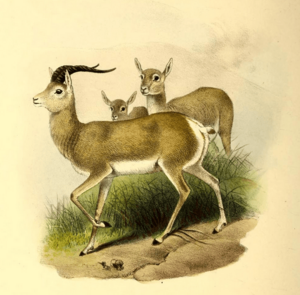Goa (antelope) facts for kids
Quick facts for kids Goa |
|
|---|---|
 |
|
| From North Sikkim, India | |
| Conservation status | |
| Scientific classification | |
 |
|
| Population range |
The goa (scientific name: Procapra picticaudata), also called the Tibetan gazelle, is a type of antelope. It lives on the high Tibetan plateau in Asia.
Contents
About the Goa
The goa is a fairly small antelope. It has a slim and graceful body. Both male and female goas are about 54 to 65 centimetres (21 to 26 in) tall at the shoulder. They measure 91 to 105 cm (36 to 41 in) from head to body and weigh 13 to 16 kg (29 to 35 lb).
Physical Features
Male goas have long, ridged horns that can be 26 to 32 cm (10 to 13 in) long. These horns are close together on their forehead. They grow mostly straight up before curving out at the tips. Female goas do not have horns. Neither male nor female goas have special markings on their faces.
The goa's body is mostly grayish-brown. Its summer coat is usually lighter gray than its winter coat. It has a short tail with a black tip. This tail is in the middle of its white, heart-shaped rump patches.
Goas have fur made of long guard hairs, but no soft undercoat. Their fur gets thicker in winter to keep them warm. They have excellent senses, including very good eyesight and hearing. Their long, thin legs help them run fast. This speed is important for escaping from predators.
Where Goas Live
The goa lives on the Tibetan plateau. It is found across this large region. Goas live in areas that are very high up, between 3,000 and 5,750 m (9,840 and 18,860 ft) above sea level.
Habitat and Location
Most goas live in the Chinese provinces of Gansu, Xinjiang, Tibet, Qinghai, and Sichuan. Small groups also live in the Ladakh and Sikkim regions of India. There are no known different types of goa (subspecies).
Goas mainly live in alpine meadows and high-elevation steppe areas. They are spread out across their range in many small herds. These herds are often far apart from each other. The number of goas in an area can vary a lot.
Goa Behavior and Diet
Goas do not form very large herds like some other animals. They are usually found in small family groups. Sometimes, they might gather into bigger groups. However, most goa groups have fewer than 10 animals. Many goas even live alone.
Goas make short cries and calls. They use these sounds to warn their group if a predator or danger is near.
Goas eat different plants found in their area. They mostly eat forbs (flowering plants) and legumes (like peas or beans). They also eat smaller amounts of grasses and sedges. The main animals that hunt goas are the Himalayan wolf and the snow leopard.
Goa Life Cycle
For most of the year, male and female goas live separately. Females usually graze in higher areas than males. The females come down from these high pastures around September. This happens before the mating season, which is in December.
Reproduction
During the mating season, male goas are mostly solitary. They mark their territories with scent to show other males it's their area. Sometimes, males will butt or wrestle with their horns against rival males.
A female goa is pregnant for about six months. She usually gives birth to one young goa between July and August. The baby goas stay hidden with their mother for about two weeks. After that, they join the rest of the herd. We don't know exactly when goas become old enough to have their own babies. However, it's probably around 18 months old. Goas have lived for up to five years and seven months in zoos.
Conservation Status

The number of goas has gone down in recent years. However, they mostly live in areas where there aren't many people. They also don't compete much with local farm animals for food. Because goas are small, they are not often hunted. In China, they are a protected species.
The biggest threats to goas in China are losing their habitat. This happens when people move into their natural areas with their livestock (pastoralism) or when farms expand.
Challenges in Ladakh
In Ladakh, goas live at very high altitudes (4,750 to 5,050 metres (15,580 to 16,570 ft)). They prefer flat areas and warmer, south-facing slopes. They can live alongside domestic yaks and kiang (wild donkeys). However, they compete with domestic goats and sheep for food. They also try to avoid herders and their dogs.
The goa population in Ladakh is very small, less than 100 animals, and it continues to shrink. In the early 1900s, goas were found as far west as the Tsokar Basin. Today, they are only found in the Hanle Valley and nearby areas like Chumur. Goas are facing problems from poor pasture conditions. They also suffer from issues related to small populations, like a lack of different genes. This makes them less able to fight off diseases.
Goa populations in both Ladakh and Tibet seem to be decreasing quickly. They are in danger of disappearing, at least in some areas. A small group also lives in northern Sikkim, near the border between India and Chinese-controlled lands. These goas seem to move between the two countries.




